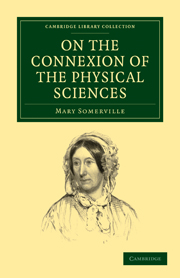ON THE CONNEXION OF THE PHYSICAL SCIENCES
Published online by Cambridge University Press: 29 August 2010
Summary
All the knowledge we possess of external objects is founded upon experience, which furnishes facts; and the comparison of these facts establishes relations, from which induction, the intuitive belief that like causes will produce like effects, leads to general laws. Thus, experience teaches that bodies fall at the surface of the earth with an accelerated velocity, and with a force proportional to their masses. By comparison, Newton proved that the force which occasions the fall of bodies at the earth's surface, is identical with that which retains the moon in her orbit; -and induction led him to conclude that, as the moon is kept in her orbit by the attraction of the earth, so the planets might be retained in their orbits by the attraction of the sun. By such steps he was led to the discovery of one of those powers with which the Creator has ordained that matter should reciprocally act upon matter.
Physical astronomy is the science which compares and identifies the laws of motion observed on earth with the motions that take place in the heavens; and which traces, by an uninterrupted chain of deduction from the great principle that governs the universe, the revolutions and rotations of the planets, and the oscillations of the fluids at their surfaces; and which estimates the changes the system has hitherto undergone, or may hereafter experience—changes which require millions of years for their accomplishment.
- Type
- Chapter
- Information
- On the Connexion of the Physical Sciences , pp. 1 - 414Publisher: Cambridge University PressPrint publication year: 2009First published in: 1834



